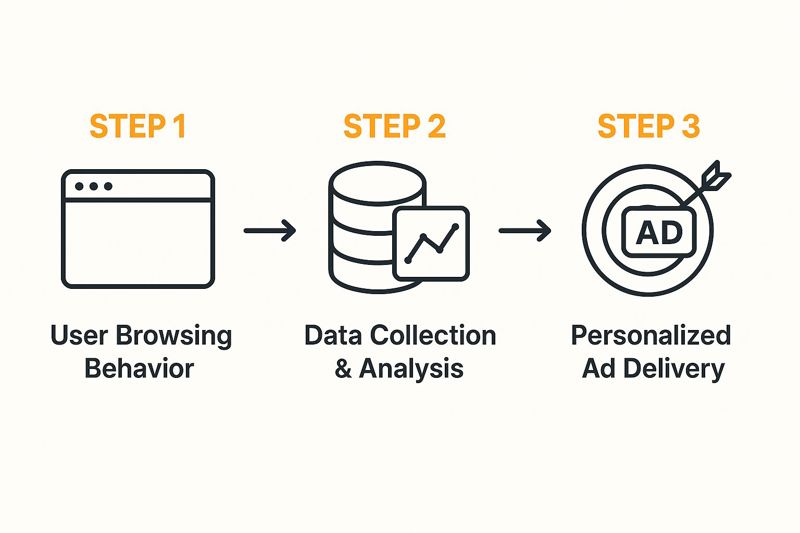At its core, behavioral targeting is a digital marketing strategy that delivers ads and content based on what a user has actually done online. Instead of blasting everyone with the same generic message, it tunes into individual behaviors—like websites visited, products added to a cart, or articles read—to make every interaction far more relevant.
Understanding Behavioral Targeting

Imagine walking into a bookstore where, instead of random displays, the front tables are stacked with books by authors you’ve bought before. That’s the magic of behavioral targeting in the digital world. It steps beyond broad, often clumsy demographic data like age or location and focuses on what really matters: a person's demonstrated interests and intent.
This approach works by using anonymous data, typically gathered through browser cookies and tracking pixels, to build a profile of a user’s digital footprint. These individual profiles are then grouped into audience segments.
- Outdoor Enthusiasts: People who browse hiking gear, read travel blogs about national parks, and watch videos on camping.
- Home Chefs: Users who look up recipes, shop for specialty kitchen gadgets, and follow food bloggers on social media.
- Tech Aficionados: Individuals who read product reviews for new gadgets, visit tech news sites, and compare smartphone specifications.
Once these segments are defined, marketers can deliver ads that speak directly to those specific interests.
To really grasp the shift, it helps to see how behavioral targeting stacks up against older methods.
Behavioral Targeting vs Traditional Targeting
| Aspect | Behavioral Targeting | Traditional (Demographic) Targeting |
|---|---|---|
| Data Source | User actions, browsing history, clicks, purchase intent | Age, gender, location, income |
| Focus | "What are you interested in right now?" | "Who are you?" |
| Precision | Highly specific and dynamic | Broad and static |
| Example | Showing running shoe ads to someone who just searched for marathon training plans. | Showing running shoe ads to all males aged 25-40 in a specific city. |
As you can see, the difference isn't just a small tweak—it's a fundamental change in how we think about reaching an audience.
Why This Shift Matters
The impact of this strategy is huge, and it’s a win-win for both businesses and consumers. For companies, it means less wasted ad spend and much more effective campaigns. The proof is in the numbers: research shows that targeted advertising generates roughly 2.7 times more revenue per ad compared to non-targeted ads.
For consumers, the benefit is a cleaner, more helpful online experience. Instead of being bombarded with irrelevant promotions, they discover products and services that genuinely align with their needs and curiosities.
This dynamic creates a more efficient and respectful digital marketplace. It allows brands to connect with people who are already looking for what they offer, paving a natural path to conversion. It’s all about replacing disruptive, one-size-fits-all advertising with a smarter approach that respects the user's journey. You can learn more about how this fits into the bigger picture by reading our guide on what personalization in marketing truly means.
The Mechanics of Behavioral Targeting
To really get what behavioral targeting is all about, you have to look under the hood. It’s the magic that turns a simple search for hiking boots into a perfectly timed ad for camping gear on a totally different website just moments later.
This journey all starts with data collection, powered by a few small, nearly invisible bits of tech.
Following the Digital Breadcrumbs
Gathering user information relies on a few key tools working quietly in the background. They collect anonymous data about what we do online, piecing together a digital footprint of our interests and what we might be looking to buy.
- Cookies: Think of these like digital nametags. When you land on a website, a tiny text file is placed on your browser. This lets sites remember you, see what you do, and recognize you when you come back or visit other sites in their ad network.
- Tracking Pixels: These are microscopic, invisible images embedded in websites and emails. When you load a page with a pixel, it sends a signal back to a server, confirming you took a specific action, like viewing a product or opening an email.
- Device IDs: For mobile users, every smartphone or tablet has a unique identifier. This lets marketers track your behavior within and across different apps on your device, much like how cookies operate on a web browser.
This simple graphic breaks down the flow from a user's action to the final ad they see.

As you can see, the process moves from watching behavior to analyzing it, and then using those insights to serve up a relevant ad.
From Data Points to Audience Segments
This raw data isn’t very useful on its own. It’s just a jumble of clicks and page views. The real work happens when sophisticated platforms organize and make sense of it all.
At its core, behavioral targeting is an advanced form of customer segmentation, allowing marketers to group users based on their actions. For more on structuring your segmentation, explore these advanced customer segmentation strategies.
Platforms like Data Management Platforms (DMPs) pull in this anonymous data from all over the web. They then crunch the numbers and spot patterns, grouping users into audience segments based on shared interests. Think "Outdoor Enthusiasts," "Tech Gadget Shoppers," or "Frequent Travelers."
Finally, the magic moment. When a user from one of these segments visits a website with ad space, an automated bidding war happens in the blink of an eye. Advertisers bid to show their ad to that specific user, and the winner gets to display their ad—perfectly matched to what that person is already interested in.
The Benefits for Marketers and Customers

When done right, behavioral targeting isn't a zero-sum game; it creates a genuine win-win. For businesses, it turns marketing from an expensive guessing game into a data-driven science. For customers, it declutters their digital world and makes it far more relevant.
Think of it this way: instead of shouting into a crowded stadium, you get to have a quiet, one-on-one conversation with people who actually want to listen. That kind of precision leads to major gains for everyone.
Advantages for Marketers
For any business that wants to grow, behavioral targeting unlocks a new level of efficiency and impact. The real magic comes from putting your resources exactly where they'll do the most good—in front of receptive audiences.
- Higher Conversion Rates: If you show an ad for hiking boots to someone who just read three articles about local trails, you’re meeting them at the peak of their interest. This natural alignment makes a sale far more likely.
- Improved Return on Investment (ROI): Wasted ad spend plummets when you’re no longer paying to reach people with zero interest in your products. Every dollar goes toward users who have already shown intent, making your campaigns significantly more cost-effective.
- Enhanced Customer Engagement: Relevant content is sticky. When your ads and recommendations feel genuinely helpful instead of intrusive, customers are more likely to interact, building stronger, more loyal relationships with your brand over time.
This shift from broad-stroke advertising to sharp, specific targeting has a massive effect. In fact, around 76% of consumers say they are more likely to buy from brands that personalize their marketing. That kind of personalized engagement translates directly into a healthier marketing ROI. You can read more on why this targeting matters on NotificationX.
Better yet, automating much of this process frees up your team to focus on big-picture strategy instead of getting bogged down in manual segmentation. To see how this fits into a wider plan, check out our ultimate guide to marketing automation strategy.
Benefits for Customers
But the perks aren't just for businesses. When executed thoughtfully, this approach dramatically improves the online experience for consumers, transforming a chaotic digital space into a curated one.
The biggest benefit is simple: relevance.
Instead of being hit with a firehose of ads for things they’d never buy, people discover products and services that actually line up with their needs and interests. A home baker sees a great deal on a new stand mixer, not a random promotion for truck parts.
This makes the experience feel more like discovery and less like a disruption. Personalized offers can feel like a helpful tip from a friend, making the entire journey from browsing to buying much smoother and more enjoyable. In the end, customers find what they want faster and with less noise, making the digital world a more efficient and satisfying place for us all.
Behavioral Targeting Examples in the Real World
Theory is one thing, but behavioral targeting is a strategy you run into every single day—often without even realizing it. These aren’t abstract concepts; they are the subtle, helpful, and sometimes surprisingly accurate interactions that shape your online experience.
From e-commerce to entertainment, this approach turns anonymous browsing into a personalized conversation.
The most classic and relatable example? The abandoned cart email. You spend time browsing an online store, find a pair of shoes you love, add them to your cart... but then you get distracted and leave. An hour later, an email lands in your inbox with a picture of those exact shoes, asking, "Still thinking it over?"
This isn’t a coincidence. The retailer's system tracked your behavior—adding an item to your cart but not completing the purchase—and automatically triggered a personalized reminder. It's a simple yet powerful tactic that recovers tons of potentially lost sales.
Personalization on a Massive Scale
Now, let's look at the giants of personalization, like Amazon and Netflix. These platforms have turned behavioral targeting into an art form.
- Amazon's Recommendation Engine: When you see carousels labeled "Inspired by your shopping trends" or "Customers who viewed this item also viewed," that's behavioral targeting at work. The platform analyzes everything—products you've viewed, items you've purchased, and even how long you've lingered on a page—to predict what you might want next.
- Netflix's Content Suggestions: Ever wonder how Netflix knows you'd love that obscure documentary after you just finished a three-season crime drama? Its algorithm tracks what you watch, what you abandon halfway through, what you rate highly, and even the time of day you watch. This data creates a highly customized homepage designed to keep you engaged and subscribed.
The goal of these systems is to create a seamless user experience where discovery feels natural, not forced. It’s wildly effective. According to one analysis, a staggering 35% of Amazon's revenue is generated by its recommendation engine, all fueled by behavioral data.
Dynamic Content in Action
Beyond product recommendations, behavioral targeting can change the very content you see. Imagine a travel website showing a visitor from a cold, snowy city images of sunny beaches, while a visitor from a hot region sees ads for a cool mountain getaway.
This is where dynamic content shines. For instance, OKZest allows marketers to create personalized images that change based on user data. A user who frequently browsed budget-friendly travel packages might see an image with their name and a special offer for an affordable destination.
Here’s an example right from the OKZest homepage showing how images can be personalized at scale.
The image demonstrates how a single template can generate unique visuals for different recipients, incorporating names and specific details.
This level of personalization grabs attention far more effectively than a generic graphic. By combining behavioral insights with adaptable visuals, you can create truly one-of-a-kind experiences. To explore more ways this works, check out these powerful dynamic content examples that can transform user experience. Each example shows how data-driven actions can make marketing more relevant and effective.
Navigating Privacy in a Cookieless Future

You can't talk about behavioral targeting without addressing the elephant in the room: privacy. While we all love a good recommendation, there's a razor-thin line between a helpful suggestion and an ad that feels like it’s listening to your thoughts. This "creepiness factor" is a very real thing for customers and a huge challenge for marketers to get right.
The entire landscape is being reshaped right now, pushed along by customers demanding more control and landmark rules like GDPR. Regulations like this mean businesses now need to get clear, explicit consent before they can collect and use personal data. The old playbook has been tossed out the window.
At the same time, we're marching toward a cookieless future. The big web browsers are all phasing out the third-party cookies that have fueled cross-site tracking for decades. The old-school methods of following people around the internet are quickly going extinct, forcing everyone to evolve.
Thriving in the New Era of Privacy
This isn't a roadblock—it's a chance to build much stronger, more honest relationships with your customers. The best way forward is to be transparent and double down on data that people are happy to share with you. It all comes down to ethical practices that respect a person's right to choose.
Think of these as the pillars for a modern, privacy-first strategy:
- Radical Transparency: Be completely upfront about what data you collect and how you use it. Ditch the legal jargon in your privacy policies and consent pop-ups. Make it dead simple for people to see how their information creates a better experience for them.
- Meaningful User Control: Give people easy-to-use tools to manage their own data preferences. A hidden "opt-out" link isn't good enough anymore. Let them have granular control over what they share.
- Embrace First-Party Data: The most powerful data you have is the data your audience gives you directly. This is the goldmine of info from website sign-ups, purchase histories, email clicks, and survey responses—all gathered with their full consent.
The future of marketing is a value exchange. When you offer real value through great content, products, or experiences, customers are far more willing to share their information. Suddenly, privacy isn't a hurdle; it's the foundation for lasting loyalty.
The Power of Your Own Data
Making the switch to focus on first-party data is the single biggest move you can make. Not only is this information more accurate and relevant, but it’s also collected ethically, with permission from your audience. When you use what your customers tell you directly, you can keep delivering personal, effective campaigns that everyone feels good about.
This approach creates a sustainable way to grow. It shifts your marketing away from a reliance on murky, third-party systems and toward a direct, transparent relationship with the people who actually matter: your customers.
Best Practices for Effective Campaigns
Putting behavioral targeting into action is more of an art than a science. It’s not just about collecting data; it's about using those insights to build campaigns that connect with people without creeping them out. This means getting smart with your audience segments, testing everything, and never, ever forgetting that you’re marketing to humans who value their trust.
A killer campaign always starts with great segmentation. You need to dig deeper than simple page visits and look for the breadcrumbs that signal real intent. Instead of just lumping everyone who visited your website into one bucket, create a segment for users who viewed a specific product three times, watched a demo video, and then checked out the pricing page. That’s a user who is miles closer to buying.
Prioritize Transparency and First-Party Data
In a world where privacy is front and center, how you collect data is just as important as the ads you create. The best campaigns are built on trust, and that begins with being upfront and relying on data people willingly give you.
- Be Radically Transparent: Make your privacy policy easy to find and even easier to read. Ditch the legal jargon and explain in plain English what you’re collecting and why it helps create a better experience for them. A confusing policy just makes you look shady.
- Leverage First-Party Data: Your best source of truth is the data you collect directly from your audience. Think email sign-ups, purchase histories, or survey responses. This information is not only more accurate, but it’s gathered with consent, building a solid relationship from the get-go.
The most effective campaigns strike a delicate balance: delivering highly relevant content while fiercely respecting user privacy. When you get this right, your marketing starts to feel more like a helpful service and less like surveillance. That’s how you build real loyalty.
Test, Measure, and Optimize Continuously
Finally, never assume your first attempt is your best one. Marketers who get behavioral targeting right are constantly testing and tweaking. This is where you might lean on comprehensive guides covering things like effective Google Ads audience targeting strategies to inform your experiments. Rigorous testing is simply not optional.
Always be A/B testing different ad creatives, messaging, and offers for each of your segments. What resonates with one group might totally fall flat with another. By constantly watching performance metrics like click-through rates and conversions, you can fine-tune your approach and make sure your campaigns get sharper and more efficient over time.
Common Questions About Behavioral Targeting
Once you start getting the hang of behavioral targeting, a few questions always seem to pop up. Let's clear up some of the most common ones to give you a solid footing before you start putting these ideas into practice.
Behavioral vs. Contextual Targeting
The big difference here comes down to the data you're looking at.
Behavioral targeting is all about the person. It tracks someone's past actions—the articles they’ve read, the products they’ve clicked on across different sites—to guess what they’ll be interested in next. It's why you see an ad for a tent on a news website a day after you were browsing hiking blogs.
Contextual targeting, on the other hand, is all about the place. It doesn't care who you are or what you've done before. It just matches the ad to the content of the page you're on right now. Think of an ad for a spatula showing up next to a recipe for pancakes. That’s contextual targeting in a nutshell.
Behavioral targeting follows the person, showing them relevant ads wherever they go. Contextual targeting stays put, matching ads to the environment of a specific page.
Is Behavioral Targeting Legal with GDPR?
Yes, it is, but you have to play by the rules. Regulations like GDPR and CCPA don't outlaw behavioral targeting, but they do demand that you're upfront and honest about it.
It all boils down to a few key things: getting clear, enthusiastic consent from users before you collect any data, telling them exactly what you’re doing with it, and giving them an easy way to say "no thanks" and opt out. Consent and transparency aren't just suggestions; they're the foundation.
How Can Small Businesses Get Started?
You don't need a massive budget or a dedicated data science team to get started. Small businesses can jump right in using the tools already built into platforms like Google Ads and Meta.
A great first move is to install a tracking pixel on your website. This little piece of code lets you run retargeting campaigns—showing your ads to people who have already stopped by your site. It’s a simple, powerful, and incredibly effective way to get your feet wet.
Ready to create hyper-relevant experiences for your audience? OKZest helps you automate personalized images for every email, chatbot message, or website visit. See how you can boost engagement by visiting https://okzest.com.